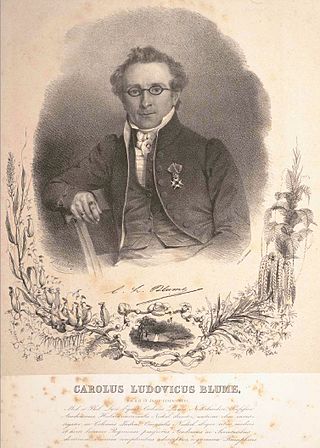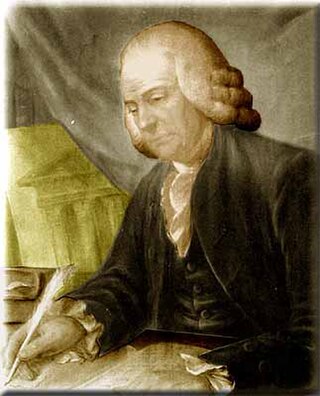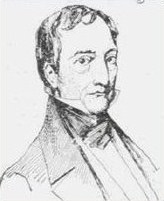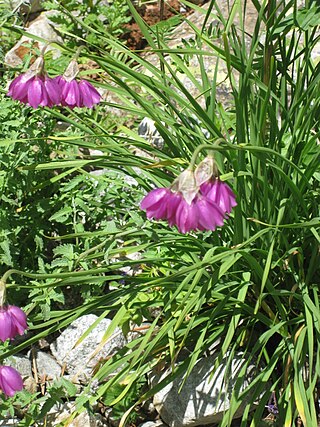
Albrecht von Haller was a Swiss anatomist, physiologist, naturalist, encyclopedist, bibliographer and poet. A pupil of Herman Boerhaave, he is often referred to as "the father of modern physiology."

Johann Georg Gmelin was a German naturalist, botanist and geographer.

Charles Ludwig de Blume or Karl Ludwig von Blume was a German-Dutch botanist. The standard author abbreviation Blume is used to indicate this person as the author when citing a botanical name.

Nikolaus Joseph Freiherr von Jacquin was a scientist who studied medicine, chemistry and botany.

Conrad Moench was a German botanist, professor of botany at Marburg University from 1786 until his death.

Jean-François Séguier was a French archaeologist, epigraphist, astronomer and botanist from Nîmes.
William Hudson FRS was a British botanist and apothecary based in London. His main work was Flora Anglica, published in 1762. He was elected a fellow of the Royal Society in 1761.

Luigi Aloysius Colla was an Italian botanist of the late 18th and early 19th Centuries. He was a member of the Provisional Government of Savoy from December 12, 1798, to April 2, 1799, taking his turn as chairman of the government in rotation for a ten-day term. In 1820 Colla described two species, Musa balbisiana and Musa acuminata, that are the basis for almost all cultivated bananas. Colla was a member of the Philadelphia Academy of Natural Sciences.

Najas minor, known as brittle naiad or brittle waternymph, is an annual aquatic plant, a submersed herb. It is native to Europe, Asia and North Africa from the Netherlands to Morocco east to Japan and the Philippines, including China, Siberia, Central Asia, Iran, Turkey, Ukraine, Germany, France Italy and a host of other countries. It is now introduced to North America and considered a weedy invasive species in the eastern half of the United States from Florida to Oklahoma to New Hampshire to Ontario to South Dakota. This plant prefers calm waters, such as ponds, reservoirs, and lakes, and is capable of growing in depths up to 4 meters.
Johann Anton Weinmann was a German botanist who served as Inspector of the Gardens in Saint Petersburg, Russia. He published a Flora that is the basis of some binomial species identifications.

Galium murale is a species of flowering plant in the coffee family known by the common names small goosegrass, yellow wall bedstraw and tiny bedstraw. It is native to the Mediterranean Basin of southern Europe and northern Africa, and the Middle East from Turkey and the Caucasus east to Iran and south to Saudi Arabia and Somalia. It is also considered native to the Canary Islands, Madeira and the Azores. It is naturalised in Australia, New Zealand, Argentina, Chile and California.

Ignacio Jordán Claudio de Asso y del Río was a Spanish diplomat, naturalist, lawyer and historian. He sometimes used the pseudonym of Melchor de Azagra.

Eduard Fenzl was an Austrian botanist.
Caleb Threlkeld (1676–1728) was an Irish botanist, dissenting cleric and physician.

Giuseppe Giacinto Moris was an Italian botanist known for investigations of flora native to Sardinia.
Franz Xaver Heller was a German physician and botanist.

Allium flavum, the small yellow onion or yellow-flowered garlic, is a species of flowering plant in the genus Allium. A bulbous herbaceous perennial, it is native to the lands surrounding the Mediterranean, Black, and Caspian Seas, from France + Morocco to Iran + Kazakhstan.

Allium insubricum, the Lombardy garlic, is a species of flowering plant endemic to the Lombardy region in northern Italy. It is named for Insubria, the ancient name for the area around present-day Milan. The species is, however, widely cultivated as an ornamental because of its striking flowers. Its locus classicus is located in Canzo.

Campanula alpestris, the alpine bellflower, is a species of flowering plant in the family Campanulaceae. It is native to the southwestern European Alps.

Martino Anzi was an Italian priest, ethnologist, historian and botanist. He is particularly noted for his floristic studies of Italian lichens.

















